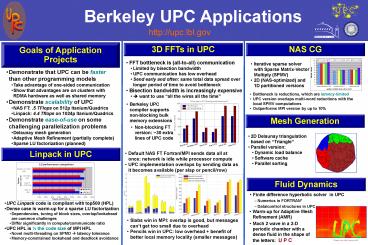Berkeley UPC Applications - PowerPoint PPT Presentation
1 / 1
Title:
Berkeley UPC Applications
Description:
256.00 22478.70 22686.59 21920.92 22321.99 23758.26 113166.46 256.00 0.00 0.00 256.00 51.59 13206.16 256.00 53.41 13672.69 256.00 64.17 16427.49 256.00 56.57 14482 ... – PowerPoint PPT presentation
Number of Views:38
Avg rating:3.0/5.0
Title: Berkeley UPC Applications
1
Berkeley UPC Applications
http//upc.lbl.gov
Goals of Application Projects
3D FFTs in UPC
NAS CG
- FFT bottleneck is (all-to-all) communication
- Limited by bisection bandwidth
- UPC communication has low overhead
- Send early and often same total data spread over
longer period of time to avoid bottleneck - Bisection bandwidth is increasingly expensive
- ? want to use all the wires all the time
- Iterative sparse solver with Sparse Matrix-Vector
Multiply (SPMV) - 2D (NAS-optimized) and 1D partitioned versions
- Demonstrate that UPC can be faster than other
programming models - Take advantage of one-sided communication
- Show that advantages are on clusters with RDMA
hardware as well as shared memory - Demonstrate scalability of UPC
- NAS FT .5 TFlops on 512p Itanium/Quadrics
- Linpack 4.4 Tflops on 1024p Itanium/Quadrics
- Demonstrate ease-of-use on some challenging
parallelization problems - Delaunay mesh generation
- Adaptive Mesh Refinement (partially complete)
- Sparse LU factorization (planned)
- Bottleneck is reductions, which are
latency-limited - UPC version overlaps multi-word reductions with
the local SPMV computations - Outperforms MPI version by up to 10
- Berkeley UPC compiler supports non-blocking bulk
memory extensions - Non-blocking FT version 30 extra lines of UPC
code
Mesh Generation
- 2D Delaunay triangulation based on Triangle
- Parallel version
- Dynamic load balance
- Software cache
- Parallel sorting
Linpack in UPC
- Default NAS FT Fortran/MPI sends data all at
once network is idle while processor compute - UPC implementation overlaps by sending data as it
becomes available (per slap or pencil/row)
Fluid Dynamics
- Finite difference hyperbolic solver in UPC
- Numerics in FORTRAN
- Data/control structures in UPC
- UPC Linpack code is compliant with top500 (HPL)
- Dense case is warm-up for a sparse LU
factorization - Dependencies, tuning of block sizes,
overlap/lookahead are common challenges - Differ significantly in compute/communicate ratio
- UPC HPL is ½ the code size of MPI HPL
- Novel multi-threading on SPMD ? latency tolerance
- Memory-constrained lookahead and deadlock
avoidance
- Warm-up for Adaptive Mesh Refinement (AMR)
- Mach 2 wave in a 2-D periodic chamber with a
dense fluid in the shape of the letters U P C
- Slabs win in MPI overlap is good, but messages
cant get too small due to overhead - Pencils win in UPC low overhead benefit of
better local memory locality (smaller messages)
Thanks to the ANAG group at LBL































